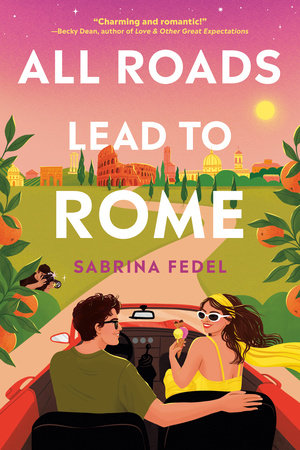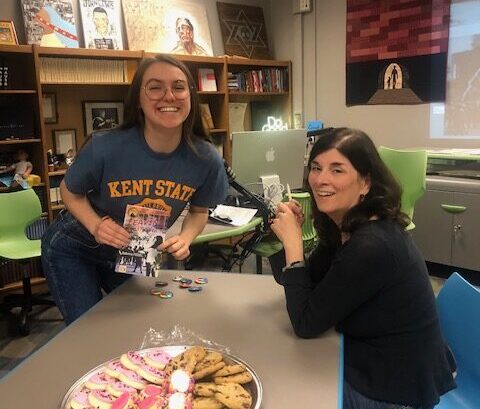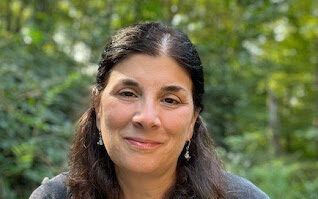Sabrina Fedel shares her experiences writing about other cultures and going from a small press to a big publishing house, and touches on some of the themes in her new YA novel, All Roads Lead to Rome, including teens navigating social media, substance abuse, and mental health.
SABRINA FEDEL – WRITING FOR YOUNG PEOPLE, JANUARY 2014

Sabrina Fedel is a writer and attorney from Pittsburgh. Her first young adult novel is the award-winning historical fiction, Leaving Kent State, published by Harvard Square Editions in 2016. Her young adult romance, All Roads Lead to Rome, is available June 18th, 2024, from Delacorte Press’ new imprint, Delacorte Romance. Sabrina’s next book, All Paths Lead to Paris, is forthcoming from Delacorte Romance in Summer, 2025. Her fiction and poetry have appeared in various journals, including Pedestal Magazine and Lunch Ticket, and she is a member of the Society of Children’s Book Writers and Illustrators. Sabrina is represented by Michelle Hauck at Storm Literary Agency.

Interview by Emily Inouye Huey
Emily Inouye Huey: We’re here to talk about your new release, All Roads Lead to Rome, a YA romance about an American expat who lives in Rome and gets swept up in a fake dating scheme with a Scottish celebrity. As this interview is for Cambridge Common Writers, a lot of our readers have associations with the Lesley MFA program. When were you there? And who did you work with?
Sabrina Fedel: I didn’t realize it until I started this interview, but this year is the 10th anniversary of my graduation from Lesley! That seems impossible to me. I did work on my first published book, Leaving Kent State, while I was a student, but only for my first semester, with Chris Lynch. I set it aside after that semester and pivoted to other work, only coming back to it after I had left school.
I really enjoyed my time at Lesley, and I can’t say enough about what I learned from Tony Abbott while I was there. Tony really taught me how to think about my work through a different lens, so in that way, he influences everything I write.
The community of writer friends I developed at Lesley has been really significant in my journey as well. It took a lot of rejections to get to a place where I could write the kinds of stories that mattered to me and still find some commercial success, and I have received so much encouragement and love over the years from my writer friends, at Lesley and beyond.
And Lesley keeps giving to me, as you and I didn’t know each other before this interview started (a while ago, now), but I count myself lucky to call you a writer friend. One of the first texts I made when the offer came in on ARLTR was to a Lesley classmate, Cynthia Platt, and Cynthia is going to be in conversation with me at Porter Square Books in August to celebrate ARLTR. So, for me, Lesley is very much something I carry with me.

Sabrina will be in conversation with fellow Lesley alum Cynthia Platt on Friday, August 16 at 7pm at Porter Square Books
EIH: Oh, I absolutely feel the same about Lesley; it’s a very special place. Your book has so much to say about celebrity culture. Your main character, Story, in some ways seems to look down on this idolization of celebrity. At the same time, there are many readers who dream of meeting their celebrity crushes, and “wish fulfillment” is such a compelling motivation for readers, particularly in this genre. What moved you to take on this topic?
SF: The subject came to me through a rabbit hole I fell into. I was trying to improve my Italian, so I was watching a lot of Italian movies and television and saw a documentary on fashion influencer-turned-entrepreneur, Chiara Ferragni. I became really fascinated in how she grew up with social media in a way that has worked for her, but which also was clearly painful and challenging. My own kids are young adults now, so I understood the challenges of teens navigating the tech world, and I was—and still am—fascinated by influencer culture. It has always existed, but the internet supercharged its ability to consume our lives in ways it never did before. I’m like Story in that I really don’t get it, so I suppose that’s why it fascinates me.
In 2023, I completed a master’s degree in information technology law. My experience as a parent navigating social media for my kids in its nascent, completely unregulated form was a big motivator for me, too. I watched my kids be hurt by social media in so many ways that I wasn’t equipped to handle as a mom. I don’t think this has really been addressed in a lot of YA books yet, and I feel very fortunate that my editor was willing to take it on, especially within a trope-y romcom.

Sabrina’s new YA novel releases June 18, 2024!
EIH: I’m grateful that your editor did! Your book was such a fun read. I read it in less than 24 hours. There is so much that I admire about how you crafted it, but one of the things that stood out from the very beginning was how vibrant and real the setting, Rome, felt. Tell us about your relationship with this iconic location, and how you approached capturing it in this book.
SF: Thank you! That means a lot to me since I admire your work! My first trip to Italy, and Rome, was when I was twelve. My parents took us so that we could meet family, as all of my grandparents were Italian immigrants. My father’s family is from the northern region and my mother’s family is from a little area south of Rome. We got to Rome, and two days later the Pope died and we were advised to flee before the crowds descended. All I really remember about Rome from that trip is that we rushed to leave the city and when we got to the train station, there were nuns everywhere! And that we stayed in what had once been a monastery.
I didn’t go back again until 2013. I took my kids to meet our family in the Alto Adige region and we spent our last days in Rome. My kids were the perfect ages for that trip, 9-15. In 2019, I took my daughter back, and she wanted to recreate that trip because she’d loved it so much—Venice to Trento and my grandmother’s village and then to Rome. So there were a lot of experiences in the book that I took from real life, but I also did a ton of research (which was really fun). Because I grew up Italian-American with first-generation parents, Italy for me is both familiar and unknown.
Italian-Americans are considered part of mainstream culture now, but my family on both sides experienced a lot of prejudice as immigrants. My maternal grandmother refused to speak Italian to her kids because it was so important to her that they be assimilated so that they wouldn’t be looked down on. Knowing what my parents experienced, I’ve always been very interested in the dynamics of culture. We think of culture as being a static experience, but it’s not. The America that I grew up in (at least in the sense of mainstream culture) isn’t the one my parents experienced and it’s definitely not the one my kids know. To be able to celebrate the wonderful and eccentric and complicated aspects of cross culture and ancestry is something I really enjoyed while writing this book.

View of the Palatine Hill from the Colosseum in Rome, Italy
EIH: Your experience and love really show. Another thing that struck me is how brave you were to approach capturing this very international group of modern, jet-setting teens—what was it like to mine for backstory when the characters are from such different places?
SF: As writers today, we are very lucky to have the world at our fingertips. What at one time would have required a trip to a particular place to discover, we can now reasonably recreate thanks to our digital, satellite world. I haven’t been to Scotland (yet—I hope to go soon as I’m now an alum of the University of Edinburgh), but I was able to dig through the internet to figure out everything I wanted to showcase in the story. I was constantly dipping into my search browser to ask for details for my characters and settings. YouTube is a wealth of travel information. I don’t know anything about sailing, but I became enraptured by a young couple who had sold everything and were sailing around the world, only to have Covid hit and be “trapped” in the Caribbean. They weren’t jet setters, but I was able to take what I learned from them and combine it with research on high-end yachts, and I think it worked pretty well (although I’m waiting for some sailor to call me out for mistakes). And the best part of research is that occasionally you stumble upon some detail you couldn’t have planned if you tried (there really is a museum of broken relationships in Zagreb!). I was also lucky to have an editor who has been to red carpet events because she was able to point out a couple of details that made those scenes more accurate.
I think it helped me, too, that I grew up around a lot of Europeans. I have a Belgian friend who lived in the States when I met her, and she once told me that I treated her differently than other Americans did, in that I just seemed to understand her and not find her odd. I think that’s because our house when I was growing up was always filled with people from other cultures, mostly European, but also South American, Asian, and African. So I’m not sure I would think of it as being brave, since I had so much exposure to different cultures growing up.

The Colosseum at night
EIH: There was also a lot in your book about language, and you wrote all these different accents! That is something that intimidates me. Tell us about your process in writing across different languages and dialects. And, just for curiosity’s sake, do you do impersonations in real life?
SF: Haha! I am terrible at languages and accents. I can hear the distinctions, but I can’t mimic them well verbally at all. I have a math disability and am a little ADD, so I’m not a detail person, which means I never get my prepositions in the correct order. But growing up as I did, especially with a lot of Irish people in our house, I heard how different the regional accents were even in a small country. And I grew up hearing some Italian. So, I took that background into my research about what characters might say. I’ve always loved Italian idioms—that part was fun for me.
As a kid, I desperately wanted to learn Italian, and spent hours trying to teach myself (not very successfully). In high school and college, I took a lot of Spanish but never really got the chance to use it and I’ve lost most of it, unless I’m struggling to think of an Italian word and then suddenly there it is! It wasn’t until language apps became accessible that I was able to finally make some real progress in learning Italian. I’m also learning French since my Belgian friend has a partner who doesn’t speak English and I want to be able to talk with him. And I’ve fallen in love with Korean television, so I tried to learn a little Hangul recently, but so far it’s blowing my mind. I’m not particularly interested in linguistics per se, but I do love how different languages intersect, and I love when a language has a simple word or phrase to describe something that would take a sentence or more to describe in English. I suppose all of that filtered into the book. I think very cinematically, so writing dialogue has always been a little easier for me than other aspects of scenes.

The church of Santa Maria di Loreto in Rome
EIH: The thing that tugged at my heartstrings most was Story’s relationship with her late father, who suffered from an opioid addiction. I could tell from how you wrote about it that our society’s treatment of those who face addiction is a topic you care about, and I appreciated your sensitive and nuanced approach. If you feel comfortable, can you speak to the choice you made to include this in your character’s arc?
SF: This is a really challenging question for me, but one I appreciate. There is so much to say about this topic, I could write a dissertation on it. Mostly it comes from my own experience loving someone with SUD [substance use disorder] and experiencing first-hand how completely inadequate our institutions are to help people, and how cruel many people in our society can be. I’ve learned a lot about mental health in the last ten years, and one big takeaway for me is that we have a lot less agency in our decision-making processes than most people realize. For example, having ADHD increases your chances of having SUD by somewhere near 90% because of the impairment to the frontal lobe, which is a crucial part of the brain for making good decisions. And that’s just one disorder. Mental illness is a particularly challenging health problem because it’s often the case that disordered thinking prevents the person afflicted from understanding or being able to act in rational ways to improve their condition. The condition is a kind of trap, where those who love the person can clearly see the way out of danger but can’t convince the person suffering of this reality. Mental illness and SUD, because they rarely are separate, are particularly cruel in this way.
At the same time that I was experiencing this, a teenage girl came into my life through one of my kids and she was suffering from this experience too. Her father had never been in her life because of his SUD, and she was struggling with her own mental health issues and didn’t really have a stable adult in her life to turn to. I wasn’t really in a place to be there for her, but I also couldn’t risk not being there. She’s a young woman now, and we are still very close. She texts me more than my own kids do. But seeing her experience, and helping her through when her dad died a few years ago, it just reinforced how little we as a society care about people with SUD, let alone the people who suffer because they love someone with it. Many of her friends won’t even touch hard drugs because they grew up without parents because of these same drugs. The opioid crisis has left a generation of young people, who are teens and young adults now and understand this pain. So I guess the book was a way of honoring these experiences for me. Because you can’t fix a societal problem until you create empathy for it. That’s what makes people want to change these big issues. I don’t expect my book to change our society, but I hope it will help some people who are suffering to feel seen.

Sabrina with a fan of her historical novel, Leaving Kent State
EIH: Thank you so much for sharing those thoughts. To shift a little, the title of your book is All Roads Lead to Rome, and I know the process of publishing this book has led you down several new roads. What are some of your takeaways from going through the submission and publication process?
SF: It’s been a very different experience for me publishing with a big house than it was to publish with a small press. I really didn’t get any marketing support before. I had to try to figure that out on my own, and it’s kind of disheartening when hardly anyone sees your book. Although, when people do find you and love your work, it’s very rewarding because it’s so rare. To have the chance to publish with a big house that has resources and knows how to get books to the readers who are eager to read them has been a really amazing experience. It’s very much a team effort, both with my agent/agency and with Penguin Random House. That’s been a really cool experience.
I think the biggest takeaway for me is how tenaciously resilient writers have to be, because we really don’t control anything except our output. We are completely dependent on finding people who connect with that output if we want to make a living (or partial living) through our writing, and there is a tremendous amount of luck and perseverance in that. As I was working on ARLTR, I told my writing group that this was as commercial as I could get, and that if this didn’t go with a big publisher, then I was going to try small press again or self-publish. I really had reached the point where I didn’t know if I’d ever have a book that more than 100 people had read. That wouldn’t have stopped me from writing, I’m like that Luke Combs song, Doin’ This, but it’s nice to have this opportunity. It also came at a crucial time for me, because I lost most of my financial security in 2019, so to have the additional income has been great. It’s challenging to keep up because I work full-time now as well, but I’ve had a lot of support from my agent and editor. The other takeaway would be that we need to surround ourselves with people who champion us. As much as I wanted and needed this chance, I wasn’t willing to sacrifice the substance use disorder aspects to make that happen, and my agent was totally supportive of this. To have an editor who also embraced this part of the story is something I will forever be grateful for.

Sabrina’s first book was the award-winning historical novel, Leaving Kent State
EIH: “Tenaciously resilient.” I love that, and I totally agree. That’s probably THE most important characteristic for aspiring writers. Before we go, could you tell us a little about what you have coming down the pipeline?
SF: Yes! My next book, All Paths Lead to Paris, will be published by Delacorte Romance in Summer ’25. In some ways, it’s similar to ARLTR in that it examines influencer culture and celebrity amidst fake dating, and it wraps some more serious topics inside of a trope-y romance. But it’s also very different, in that it features a math disabled fashion vlogger who is torn between her American and French families, and between staying an influencer or letting it all go. And there are pastries. Lots of pastries!
Listen to Sabrina Fedel read an excerpt from All Roads Lead to Rome:

Comments are closed